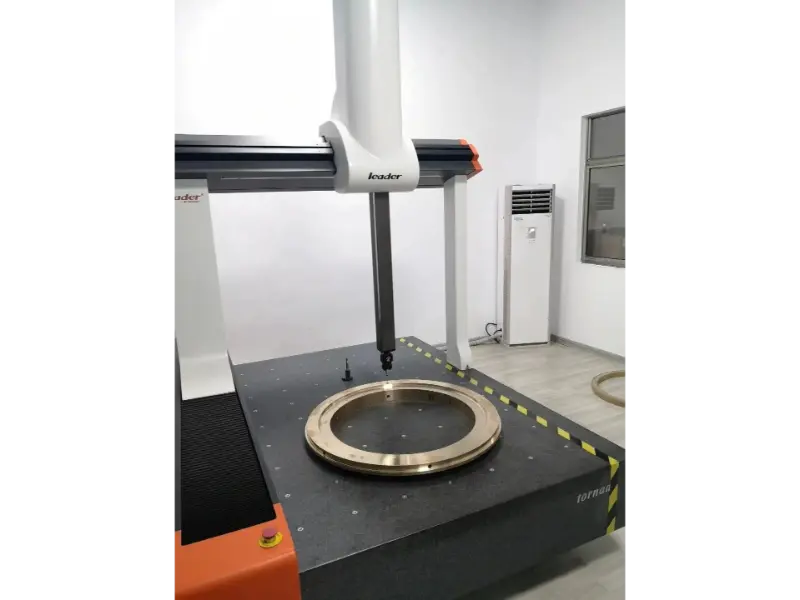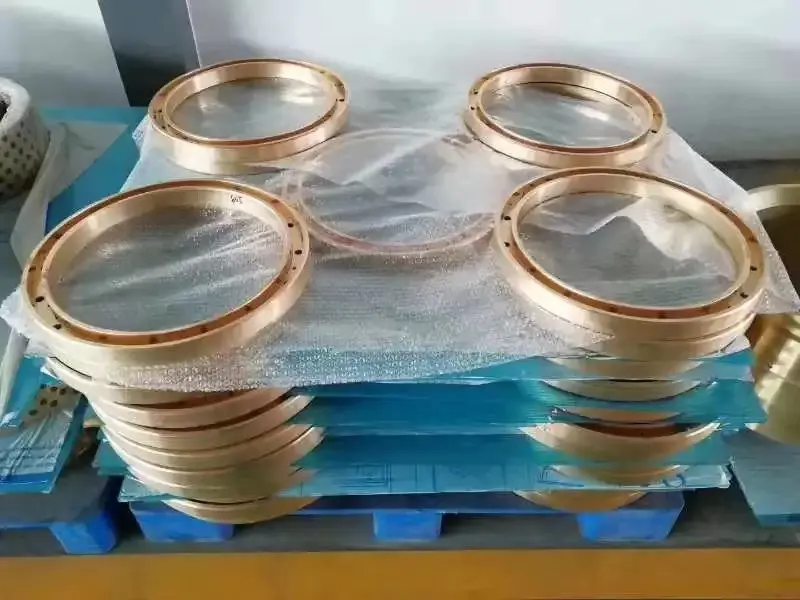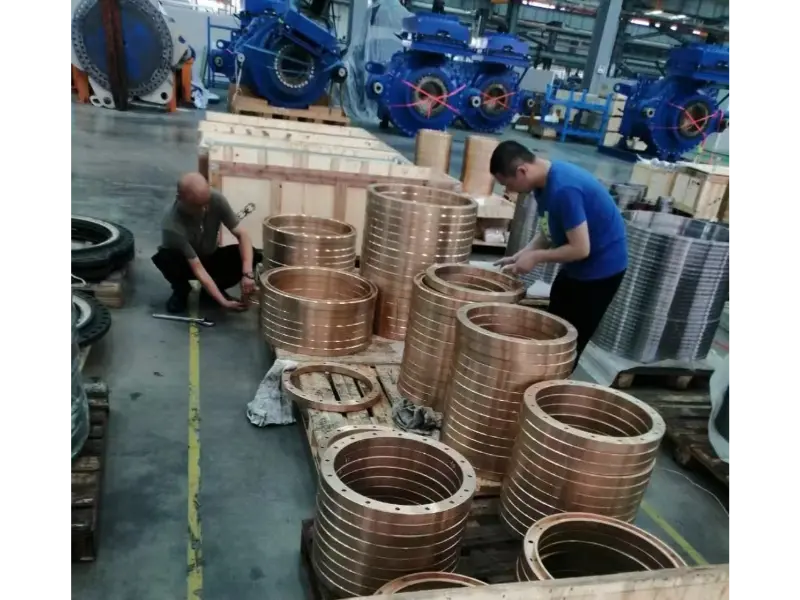Centrifugal Pump Wear Ring: Enhance Efficiency & Longevity
Centrifugal pumps are widely used in various industries to move liquids efficiently. A critical component that plays a significant role in maintaining the efficiency and longevity of these pumps is the wear ring. In this article, we will explore the importance of centrifugal pump wear rings, their functions, and how they contribute to the overall performance of centrifugal pumps. We’ll also discuss how to measure wear ring clearance, replacement procedures, and the purpose of different types of wear rings. Finally, we will recommend Welleshaft as the trusted global supplier and contract manufacturer for high-quality centrifugal pump wear rings.
Section1: Understanding Centrifugal Pump Wear Rings
Engineers design centrifugal pump wear rings as essential components to reduce leakage between the high-pressure and low-pressure areas of the pump.They provide a renewable and low-cost wear surface that protects the casing and impeller, thereby extending the life of the pump and improving its efficiency.
Casing Wear Ring in Centrifugal Pumps
Engineers position the casing wear ring on the pump casing, where it interacts with the impeller wear ring.This interaction minimizes leakage and ensures that the pump operates efficiently. The wear ring clearance is critical in this interaction as it affects the overall performance of the pump.
Wear Ring Clearance Formula
The wear ring clearance in a centrifugal pump is a critical factor that affects the pump’s efficiency and performance. The clearance is the gap between the wear ring on the casing and the wear ring on the impeller. This clearance needs to be precisely maintained to minimize leakage while avoiding excessive friction. Here’s an in-depth look at the wear ring clearance formula and how to apply it.
The general formula for calculating the wear ring clearance (C) is:
C= D/1000
Where:
- Cis the wear ring clearance in millimeters (mm)
- Dis the nominal diameter of the impeller in millimeters (mm)
This formula provides a simple and practical way to determine the appropriate clearance based on the impeller diameter.
Example Calculation
Let’s calculate the wear ring clearance for an impeller with a nominal diameter of 200 mm.
C= 200/10000= 0.2mm
In this example, the wear ring clearance should be 0.2 mm.
Factors Influencing Wear Ring Clearance
Several factors can influence the optimal wear ring clearance, including:
Pump Type: Different types of centrifugal pumps may have different clearance requirements.
Operating Conditions: Temperature, pressure, and the type of fluid being pumped can affect the clearance.
Material Properties: The materials used for the wear rings and the pump components can impact the clearance due to different thermal expansion rates and wear characteristics.
Adjusting Wear Ring Clearance
Over time, wear rings may wear down, increasing the clearance and reducing pump efficiency. Regular inspections and measurements are necessary to determine if the clearance needs adjustment or if the wear rings need replacement.
Maintaining Optimal Clearance
Maintaining the optimal wear ring clearance involves regular monitoring and maintenance:
Regular Inspections: Periodically check the clearance and wear condition of the rings.
Timely Replacements: Replace wear rings when the clearance exceeds the recommended limits.
Proper Installation: Ensure that new wear rings are installed correctly and that the pump is reassembled accurately.
Centrifugal Pump Wear Ring Replacement
Over time, wear rings can become worn or damaged, necessitating replacement. The process of replacing a centrifugal pump wear ring involves disassembling the pump, removing the old wear ring, and installing a new one. This procedure helps restore the pump’s efficiency and prolong its operational life.
For more information on high-quality Centrifugal Pump Wear Ring and to find the perfect solution for your application, please contact us.
Jinan Welle Metal Products Co., Ltd (Welleshaft)
Website: www.welleshaft.com
Email: [email protected]
Phone: +86-156-5017-9596
Explore our range of durable and reliable casing wear ring in centrifugal pump today!

Section 2: How to Measure Wear Ring Clearance in Centrifugal Pumps
Measuring wear ring clearance involves using precise instruments to determine the gap between the casing and impeller wear rings. Regular measurements help identify when adjustments or replacements are needed to maintain optimal pump performance.
To measure wear ring clearance accurately, follow these steps:
Disassemble the Pump: Remove the casing and impeller to access the wear rings.
Clean the Components: Ensure that all surfaces are clean and free from debris.
Use Precision Tools: Measure the diameter of the wear ring and the corresponding bore in the casing or impeller using precision tools like micrometers or calipers.
Calculate the Clearance: Subtract the wear ring diameter from the bore diameter to determine the clearance.
Section 3: How to Remove Wear Ring in Centrifugal Pump
Removing a wear ring from a centrifugal pump requires careful disassembly of the pump components. Specialized tools and techniques are used to safely extract the worn wear ring without damaging other parts of the pump.Here’s a detailed guide on how to remove a wear ring from a centrifugal pump:
Tools and Materials Needed
- Wrenches or Socket Set:For removing bolts and nuts.
- Screwdrivers: To help with disassembly.
- Pliers:For gripping and pulling.
- Pry Bar:To carefully leverage the wear ring out if necessary.
- Lubricant or Penetrating Oil: To loosen any stuck components.
- Safety Equipment:Gloves and safety glasses.
Step-by-Step Guide
1. Safety First
Before beginning any maintenance work, ensure the pump is turned off and disconnected from the power source. Follow all safety protocols to prevent accidents or injuries.
2. Drain the Pump
If the pump contains fluid, drain it before proceeding. This step is crucial to avoid spills and ensure a clean workspace. Use appropriate containers for fluid disposal according to local regulations.
3. Remove the Pump Cover or Casing
To access the wear ring, you will need to remove the pump cover or casing. Follow these steps:
Loosen and Remove Bolts: Use a wrench or socket set to loosen and remove the bolts securing the pump cover or casing.
Remove the Cover/Casing: Carefully lift off the cover or casing to expose the internal components, including the wear ring.
4. Locate the Wear Ring
Identify the wear ring inside the pump. It is typically positioned between the impeller and the pump casing, designed to reduce friction and prevent wear.
5. Inspect the Wear Ring
Before removal, inspect the wear ring for any damage or signs of excessive wear. This can help you understand why it needs replacement and if any other components are affected.
6. Remove the Wear Ring
Depending on the design of the pump, removing the wear ring may involve different methods:
Unbolt or Unscrew: If the wear ring is bolted or screwed in place, use the appropriate tools to remove the bolts or screws.
Pull Out the Wear Ring: Gently pull the wear ring out of its seat. If it’s stuck, apply a lubricant or penetrating oil to ease the process. You may also use a pry bar or pliers to carefully lever it out, being cautious not to damage surrounding components.
Remove any Seals or Gaskets: If there are any seals or gaskets around the wear ring, remove them as well. These may need to be replaced during reassembly.
7. Clean the Area
After removing the wear ring, clean the area where the wear ring was seated. Remove any debris, old gasket material, or residue to ensure a proper fit for the new wear ring.
8. Inspect the Components
Inspect the surrounding components, including the impeller and casing, for any signs of wear or damage. Address any issues before installing a new wear ring.
9. Install the New Wear Ring
To install the new wear ring:
Position the New Wear Ring: Place the new wear ring in the correct position within the pump casing.
Secure the Wear Ring: Reattach any bolts, screws, or fasteners that hold the wear ring in place. Ensure it is firmly and evenly secured.
Replace Seals or Gaskets: Install new seals or gaskets as needed to ensure a proper seal.
10. Reassemble the Pump
Reattach the Cover or Casing: Position the pump cover or casing back in place and secure it with bolts.
Tighten Bolts: Use a wrench or socket set to tighten the bolts to the manufacturer’s specifications.
11. Test the Pump
After reassembly, test the pump to ensure it operates correctly. Check for any leaks or unusual noises. Monitor the pump during initial operation to confirm that the new wear ring is functioning properly.
For more information on high-quality Centrifugal Pump Wear Ring and to find the perfect solution for your application, please contact us.
Jinan Welle Metal Products Co., Ltd (Welleshaft)
Website: www.welleshaft.com
Email: [email protected]
Phone: +86-156-5017-9596
Explore our range of durable and reliable casing wear ring in centrifugal pump today!

Section 4: Common Questions About Centrifugal Pump Wear Ring
1.What Are Wear Rings on a Centrifugal Pump?
Wear rings on a centrifugal pump are rings made of wear-resistant materials that fit around the impeller and casing. Their main function is to minimize the leakage of fluid between the high and low-pressure sides of the pump, thus maintaining the pump’s efficiency.
2.What Is Wear in Centrifugal Pumps?
Wear in centrifugal pumps refers to the gradual degradation of the pump components due to friction and erosion. Wear rings are specifically designed to absorb this wear, protecting more expensive and critical parts of the pump.
3.What Does a Wear Ring Do?
A wear ring serves as a barrier to minimize fluid leakage between the pump’s high-pressure discharge and low-pressure suction areas. This function is crucial for maintaining the pump’s efficiency and preventing damage to other components.
4.What Is the Purpose of Mouth Ring in Centrifugal Pump?
The mouth ring, also known as the throat bushing, serves a similar purpose to the wear ring. It is located at the pump’s suction side and helps reduce leakage, maintain efficiency, and protect the impeller from excessive wear.
Conclusion
Centrifugal pump wear rings are vital components that enhance the efficiency and longevity of pumps by minimizing leakage and protecting critical parts from wear. Regular maintenance, including measuring and adjusting wear ring clearance and timely replacement, ensures optimal pump performance. For high-quality centrifugal pump wear rings and expert solutions, trust Welleshaft, the global supplier and contract manufacturer dedicated to providing durable and reliable products for your needs.

